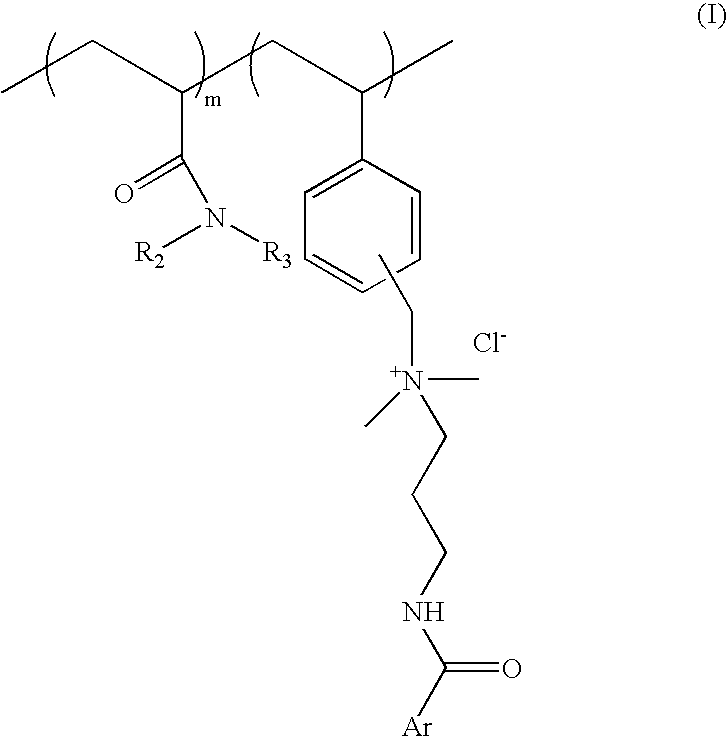Salt and heat sensitive, substantive UV-absorbing polymers
- Summary
- Abstract
- Description
- Claims
- Application Information
AI Technical Summary
Problems solved by technology
Method used
Image
Examples
example i
[0063] p-Methoxy cinnamic acid was obtained from Galaxy Surfactants Ltd., Mumbai, p-dimethylamino benzoic acid was purchased from Nagase Chemical Co., Japan, N,N-dimethyl propyl diamine from BASF, N-isopropyl acrylamide, vinyl benzyl chloride from Seimi, Japan. DMF, t-butanol, methylene chloride, thionyl chloride, acrylic acid and acetone were purchased from S. D. Fine Chem, Mumbai.
[0064] Process for preparation of cationic polymer of Formula I; wherein ArCO=p-methoxy cinnamoyl R.sub.2=--H R.sub.3=isopropyl: mole ratio, m:n::8:2
[0065] This polymer was synthesised by following three steps;
[0066] (a) Preparation of t-methoxy Cinnamidopropyldimethylamine:
[0067] Ethyl p-methoxy cinnamate (206.0 g, 1.0 mole), N,N-dimethylpropyldiamine (306.0 g, 3.0 mole) and sodium methoxide (2.0 g) were charged in a pressure reactor. The air inside the reactor was flushed out by purging of nitrogen. The reaction mixture was then stirred at 180.degree. C. (this generated pressure of 18 kg / cm.sup.2) for 3...
example ii
[0081] Process for preparation of cationic polymer of Formula I; wherein ArCO=p-methoxy cinnamoyl, R.sub.2, R.sub.3=--C.sub.2H.sub.5 mole ratio. m:n=8:2:
[0082] This polymer was synthesised by following four steps;
[0083] (a) Preparation of p-methoxy Cinnamidopropyldimethylainine
[0084] To a stirred solution of N,N-dimethylpropyldiamine (102.0 g, 1.0 mole) in dichloromethane (500 ml), solution of p-methoxy cinnamoyl chloride (196.0 g, 1.0 mole) in dichloromethane from step (a) was slowly added and the reaction was continued at room temperature for 2 hours. The reaction mixture in dichloroinethane was washed with aqueous sodium hydroxide (200 ml, 20.0%). The organic layer was dried over anhydrous sodium sulphate. The removal of solvent using a rotary evaporator afforded the p-methoxy cinnamidopropyldimethylamine (235.0 g) as colourless solid, m.p. 80.degree. C. Reversed phase HPLC showed it to be 98% pure with amine value 217.
[0085] The NMR, IR and HPLC data of p-methoxy cinnamidopropyl...
example iii
[0090] Process for preparation of cationic polymer of Formula I: wherein ArCO=p-dimethylamino benzoyl, R.sub.2=--H, R.sub.3=isopropyl: mole ratio, m:n=8:2:
[0091] This polymer was synthesised by following three steps;
[0092] (a) Preparation of p-dimethylamino Benzainidopropyldi Methylamine:
[0093] It was prepared as per the literature procedure described in U.S. Pat. No. 5,427,773 (1995).
[0094] (b) Copolymerisation of N-isopropyl Acrylainide and Vinyl Benzyl Chloride (m:n::8:2):
[0095] As described in step (b) of Example I.
[0096] (c) Quaternisation of p-dimethylainino Benzamidopropyldimethylamine with poly(N-isopropyl acrylamide-c-vinyl Benzyl Chloride):
[0097] A mixture of copolymer of N-isopropyl acrylamide and vinyl benzyl chloride (2.0 g, 3.31 mol of vinyl benzyl chloride from the previous step (b), p-dimethylamino benzamidopropyldimethylamine (0.825 g, 3.31 mmol) in isopropanol (25 ml) was stirred under nitrogen at 80.degree. C. for 48 hours. The progress of reaction was followed by...
PUM
| Property | Measurement | Unit |
|---|---|---|
| Solubility (ppm) | aaaaa | aaaaa |
| Solubility (ppm) | aaaaa | aaaaa |
| Fraction | aaaaa | aaaaa |
Abstract
Description
Claims
Application Information
 Login to View More
Login to View More - R&D
- Intellectual Property
- Life Sciences
- Materials
- Tech Scout
- Unparalleled Data Quality
- Higher Quality Content
- 60% Fewer Hallucinations
Browse by: Latest US Patents, China's latest patents, Technical Efficacy Thesaurus, Application Domain, Technology Topic, Popular Technical Reports.
© 2025 PatSnap. All rights reserved.Legal|Privacy policy|Modern Slavery Act Transparency Statement|Sitemap|About US| Contact US: help@patsnap.com



